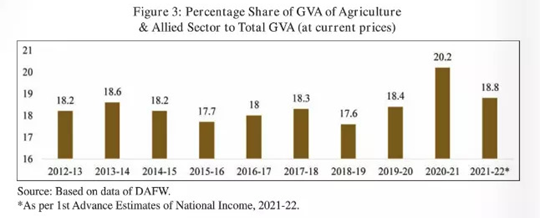India's changing agricultural landscape and its way to inclusive growth
Context
India is predominantly an agrarian economy, and its changing agricultural landscape offers a key role in promoting inclusive growth.
About
Agriculture and Inclusive growth:
- The inclusive growth approach came into being with the launching of the 11th five-year plan (2007-12). Agricultural development is an important component of an inclusive growth approach.
|
What is inclusive growth? Inclusive growth means economic growth that creates employment opportunities and helps in reducing poverty. |
- India has facilitated inclusive development in agriculture through the path of livestock and horticulture sector in the view of increasing farm income and farm sector growth.
- The three key roles agriculture can play in promoting inclusive growth - stimulating economic growth, reducing poverty, and creating employment.
- Thus, it’s a key factor for the lifeline of our Indian population and the economy’s overall productivity.
Evolution of Indian Agriculture:
- During colonial times there was a production concentration of commercial crops, while the food crops suffered from neglect.
- Post-independence, there was a need to import food grains due to the low-productivity stagnant food-crop sector, and poor rural infrastructure.
- The first three five-year-old plans didn’t yield much as more emphasis was given to capital-intensive heavy industry. Thus, we faced a crisis in food production.
- Green Revolution: Its introduction of the Green Revolution then yielded spectacular results and we became one of the largest producers of many agricultural commodities such as rice, wheat, pulses, fruits, and vegetables.
- Indian agriculture now experiences a 'problem of plenty (except edible oils).
- Indian agriculture is gaining further importance due to significant export earnings.
How does agriculture contribute to economic development?
- By providing food and raw material to non-agricultural sectors of the economy.
- By creating demand for goods produced in non-agricultural sectors, by the rural people on the strength of the purchasing power, earned by them on selling the marketable surplus,
- By providing investable surplus in the form of savings and taxes to be invested in the non-agricultural sector,
- By earning valuable foreign exchange through the export of agricultural products.
Changing Dynamics of Agriculture in India:
- Farm diversification for supplementing income: AgriTech startups and digital tools are empowering farmers to integrate livestock rearing and aquaculture into their existing operations with micro-farm installation requiring minimum space and labour.
- Improving digital & market connectivity: With ever-increasing internet and smartphone penetration, and digital connectivity, farmers can access a slew of information about farming inputs, climate conditions, and market prices.
- Availability of affordable & innovative farming inputs: Technological improvements and competition among private companies have led to a surge in the supply of quality and affordable farming inputs.
- Formal Credit Inclusion: With the emergence of Fintech and AgriTech startups, the lending landscape of the country is changing.
- The road to digital agriculture: The initiation of the Digital Agriculture Mission by the government is set to pave the way for a new and futuristic farming model in India.
Gross Value Added (GVA) in Agriculture:
- The share of the agriculture & allied sector in total GVA of the Economy and allied sector has shown a long-term (10 years) trend of around 18 percent.
- The share, however, has increased to 20.2 percent in the year 2020-21 and 18.8 percent in 2021-22.

Key trends to Expect:
- Changing demand: Demand for fruits and vegetables, dairy products, fish, and meat is going to increase in the future. There will be more demand for processed and affordable quality products.
- Use of biotechnology: To develop eco-friendly and disease-resistant, climate-resilient, more nutritious, and tastier crop varieties.
- Precision farming: Inputs will be utilized in precise amounts to get increased average yields, compared to traditional cultivation techniques such as agroforestry, crop rotation, etc.
- Use nano-technology: It will reduce the wastage in the use of chemicals, minimize nutrient losses in fertilization, and will be used to increase yield through pest and nutrient management.
- Use of digital technology: Apart from generating awareness among farmers, and information sharing, the use of satellites, IoT, and drones will be used for better collection of data regarding soil health, crop area, and yield. It will also be going to make the cost for insurers less.
- Retailing in agriculture will largely be digitalized: Over 90 percent of Kirana stores across the country will be digitalized by 2025. Many players have already taken Kirana stores to the doorsteps of consumers like Amazon and Jio Mart.





